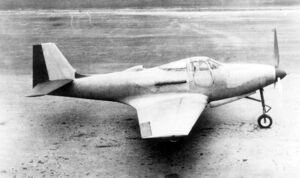Engineering:Bell P-76
| P-76 | |
|---|---|

| |
| XP-39E, the prototype of the P-76 | |
| Role | Fighter aircraft |
| Manufacturer | Bell Aircraft Corporation |
| First flight | 1942 |
| Status | Did not enter mass-production |
| Primary user | United States Army Air Forces |
| Number built | 0 (3 prototypes built as XP-39Es) |
| Developed from | Bell P-39 Airacobra |
The Bell P-76 was the proposed designation for a production model derivative of the XP-39E, a single-engine American fighter aircraft prototype of World War II.
Design and development
On 26 February 1941 the United States Army Air Corps (USAAC) placed a contract with Bell allowing for the purchase of two XP-39Es (41-19501 and 41-19502) which were envisaged to be a major improvement on the P-39D series. Because of the number of changes proposed the production model was to be called the Bell P-76.
The Bell P-76 was proposed to address the poor high-altitude performance of the P-39 Airacobra by incorporating a new and thicker wing with a symmetrical airfoil; the section chosen was NACA 0018 at the wing-root tapering to an NACA 23009 at the tip. Although the new wing has often been referred to as a laminar flow type, this was not the case.[1] The wing span was increased to 35 ft 10 in (10.9 m) and the area to 236 ft² (21.9 m²), the thicker wing allowing an increase in the fuel capacity to 150 US gallons (568 L).[2]
Design of a new Allison V-1710-E9 was also underway. This version, which had the military designation of V-1710-47, used a two-stage mechanical supercharger to increase the engine power at altitude. However, this engine went through so many design changes that it ended up being almost identical to the later V-1710-93 which was fitted in the XP-63A.[2]
Another change was the engine bay was modified to accept a more powerful engine in lieu of the V-1710. Its origins lie in the 1941 project to equip three P-39D (41-19501, 41-19502 and 42-7164) with the Continental V-1430-1 liquid-cooled supercharged engine. The resultant XP-39E had a symmetrical airfoil wing with square wingtips, an elongated fuselage to accommodate the larger engine, and revised air intakes and radiators. The three prototypes each had a different tailfin. Since the Continental engine was not available at rollout, the prototypes flew with Allison V-1710-47 engines. In 1942, the XP-39E was redesignated P-76. Although 4,000 aircraft were initially ordered, the order was cancelled to permit the Bell factory to manufacture B-29 Superfortress bomber aircraft under license from Boeing. Many of the lessons learned in the P-76 were implemented in the subsequent P-63 Kingcobra.
Specifications (P-76)
General characteristics
- Crew: 1
- Length: 31 ft 11 in (9.7 m)
- Wingspan: 35 ft 10 in (10.9 m)
- Wing area: 236 sq ft (21.9 m2)
- Empty weight: 6,936 lb (3,150 kg)
- Max takeoff weight: 8,918 lb (4,050 kg)
- Powerplant: 1 × Continental I-1430-1 , 2,100 hp (1,600 kW)
Performance
- Maximum speed: 386 mph (620 km/h, 335 kn) at 21,680 ft (6,600 m)
- Rate of climb: 2,150 ft/min (11 m/s)
Armament
- Guns:
- 1× 37 mm (1.46 in) Oldsmobile T9 cannon, 30 rounds
- 2× 0.50 in (12.7 mm) M2 Browning machine guns, 200 rounds per gun
- 4× 0.30 in (7.62 mm) M1919 machine guns, 1,000 rounds per gun
- Bombs: 500 lb (227 kg) externally
See also
Related development
Related lists
- List of military aircraft of the United States
References
Citations
- ↑ UIUC incomplete guide to Airfoil usage Retrieved: 9 August 2008
- ↑ 2.0 2.1 Bowers 1979, pp.21-25.
Bibliography
- Bowers, Peter M. "Airborne Cobra Pt.II". Airpower magazine, Vol.9, No.1, January 1979.
 |

